Yangtze River Cruise
Gorges & A Controversial Dam. Three Days Cruising Down China's Yangtze River, Aisa's Longest
“It wasn’t easy, but I eventually secured a basic berth in an even more basic 6-berth dorm on a public ferry that I shared with 5 Chinese travellers, none of which had so much as a word of English. It was an interesting time.”
Yangtze River, central China. September 26, 2004
Yangtze River Cruise, China
Chongqing, sitting almost slap-bang in the centre of south-central China, is one of the biggest cities in the country (indeed there are none larger west of here) and one of the 4 designated Chinese direct-controlled Municipalities, highest-level cities with a status equal to that of the provinces (the other 3 being Beijing, Shanghai and Tianjin). The city, a commercial centre for western China, is a transport hub and it is here that most people who embark on a Yangtze River cruise downstream begin the journey. I did.
My Yangtze Adventure
I arrived back in the city having completed my loop within a loop – my 1-week journey through the Sichuan highlights of Leshan, Emei Shan & Chengdu – & immediately began searching out ferry trips on the Yangtze. It wasn’t easy, but I eventually secured a basic berth in an even more basic 6-berth dorm on a public ferry that I shared with 5 Chinese travellers, none of which had so much as a word of English. It was an interesting time. The Yangtze River terminates in Shanghai, some 2,400 kilometres downstream from Chongqing, an enduring 6-day sail away. Thankfully I wasn’t going that far. I was heading for Yichang in Huebi Province, a 2-day, 3-night & 670-kilometre cruise way. I planned on getting off there to view the controversial Three Gorges Dam and to hop on the overnight train north to my next stop of Xi’an in Shaanix Province.
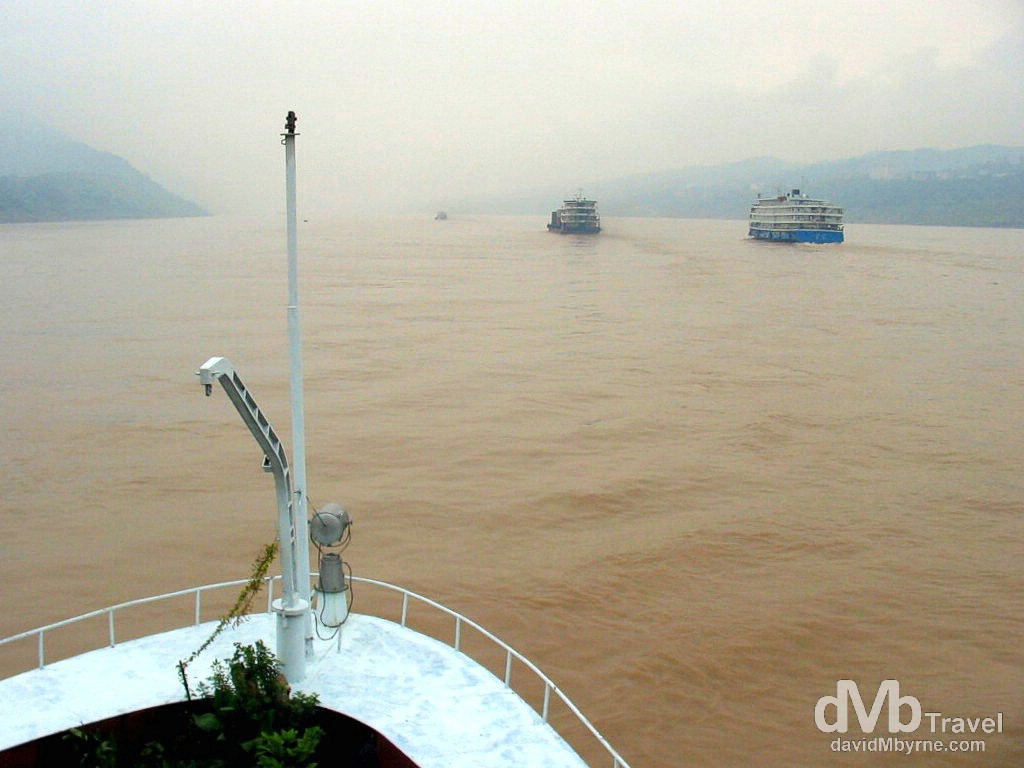
Boating on the Yangtze River, central China. September 26, 2004.
There’s not too much to report from my time on the boat. I spent most of it sitting on the forward deck with headphones on watching our progress, waving to passing ships, admiring the numerous new bridge construction projects spanning the river, and scouting various riverbank markers showing the expected level of the risen water once the dam is completed. Apart from a side trip to visit The Three Little Gorges of the larger Three Gorges, the definite highlight of any trip on the Yangtze, our progress was routinely halted as we’d stop to have a look around various towns and villages being demolished and, if they were lucky, being relocated to higher ground in preparation for the rising water levels. What follows is a pictorial recap of my trip from when we left port in Chongqing (on a Saturday evening) until disembarking in Yichang early Tuesday morning having passed through the massive locks of the still-under-construction Three Gorges Dam the previous evening. But first, a bit about the Yangtze itself.
The Yangtze River
At 6,300 kilometres long, the Yangtze River is Asia’s longest and the 3rd longest river in the world after the Nile in Africa and the Amazon in South American. Historically the river has been a political boundary between northern and southern China, due mainly to the difficulty in crossing it. From as early as the reign of the Han Dynasty (206-220 BC) the Yangtze region became crucial to China’s economy. The establishment of irrigation systems made agriculture very stable and productive, so much so that during a period of the early Qing dynasty (1636-1912), Jiangnan, lands immediately to the south of the lower reaches of the Yangtze River, provided a third to a half of the nation’s revenues.
Day 1 || Abandoned Towns, River Traffic & Construction
After departing Chongqing the previous evening, our first stop on day 1 was an early morning disembarkation at Fengdu (![]() ), a.k.a. The Ghost City, something of a Chinese tourism hotspot, for now.
), a.k.a. The Ghost City, something of a Chinese tourism hotspot, for now.
Fengdu || The Ghost City
Located about 170 kilometres downstream of Chongqing on the north bank of the Yangtze, Fengdu is something of a tourist draw because if its reputation for being the home of devils, a reputation it received by being depicted as ‘The City of Ghosts’ in two ancient, classic Chinese novels. But its days are numbered – while it was the first such town I visited on the cruise, Fengdu is just one of many population centres along the Yangtze being dismantled ahead of being flooded and lost forever to the rising waters of the river due to the construction, some 500 kilometres upstream, of the Three Gorges Dam (more on that later).
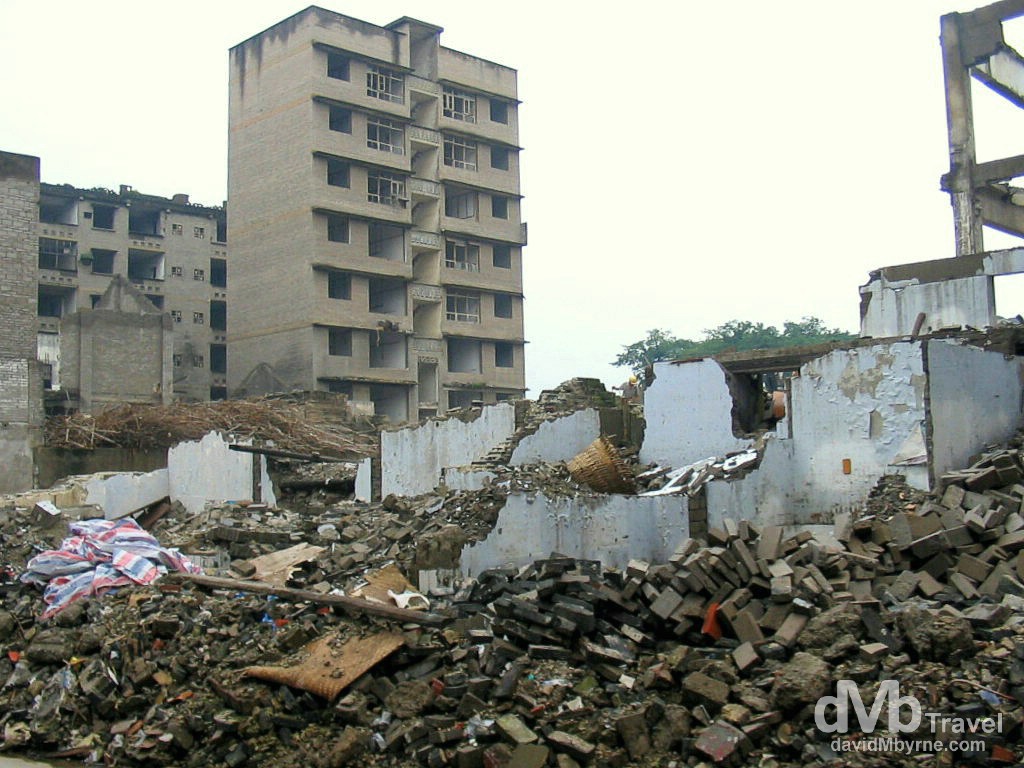
Day 1 || 07:40 || The dismantling of Fengdu, a town popular with tourists who come to visit temples and shrines dedicated to the Gods of the underworld. The scene on the streets resembled that of an abandoned war zone. Not that it really matter as soon enough all of this will be under water. Fengdu, Chongqing, China. September 26, 2004.
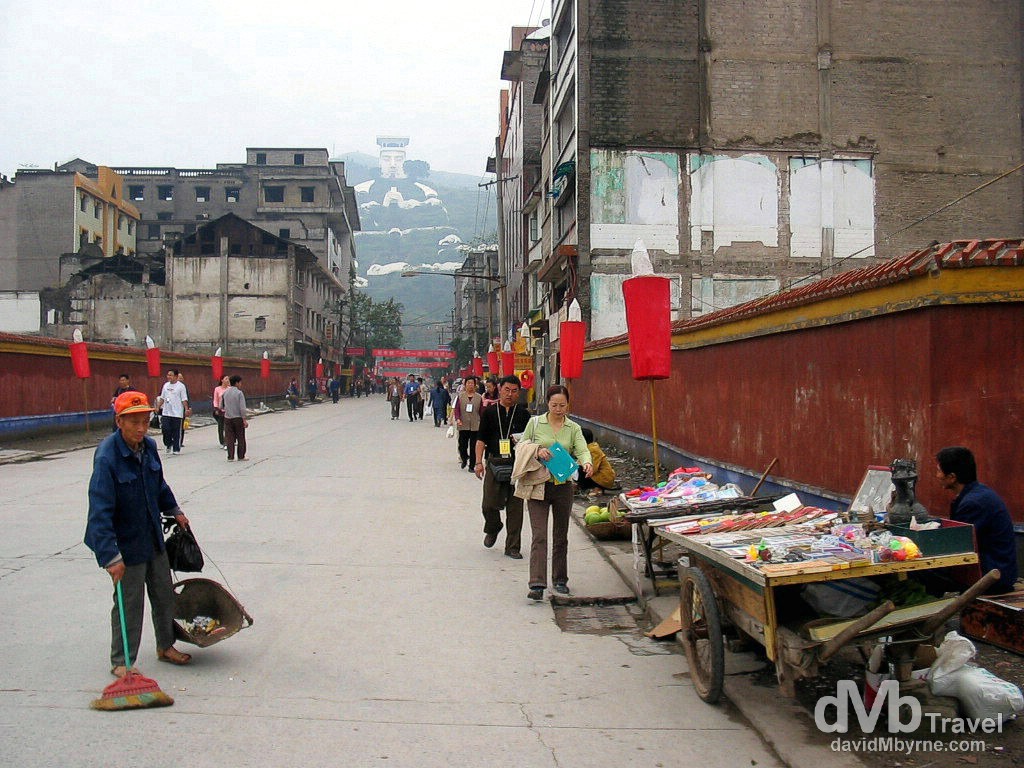
Day 1 || 08:31 || In other parts of Fengdu life goes on, but with obvious signs of the dismantling that will eventually affect the whole city. Most of the 750,000 people who lived here have already deserted it. In time the famous Ghost City will soon become an island in the reshaped Yangtze river basin, with its famous white structure on the hill in the distance one of the few structures remaining. Fengdu, Chongqing, China. September 26, 2004
Back on the river.
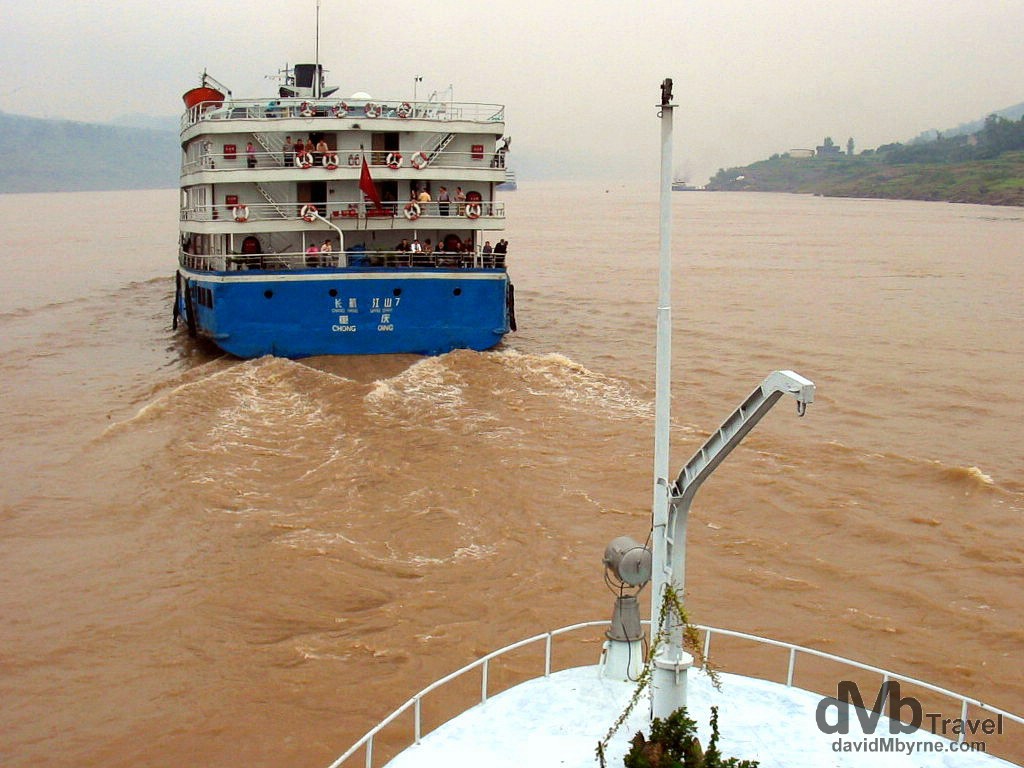
Day 1 || 10:14 || Yangtze River Traffic || A cruise on the Yangtze River has always been a popular draw for both Chinese and tourists alike but these days people are especially keen to sample the river – & specifically its most famous section, the Yangtze’s famed Three Gorges – before they are changed forever by the rising water levels. Thus there is a lot of traffic on the river with tour boats & pleasure craft plying the water during daylight hours. The river is also a hugely important transport corridor, especially for the numerous coal barges which serve the many coal storage depots visible on the banks of the river. No doubt all of this marine traffic adds to the pollution of the Yangtze, one of the dirtiest rivers in the world (although the rusty colour of the water is due to silt, not pollution). Heading downstream on The Yangtze River, Chongqing, China. September 26, 2004.
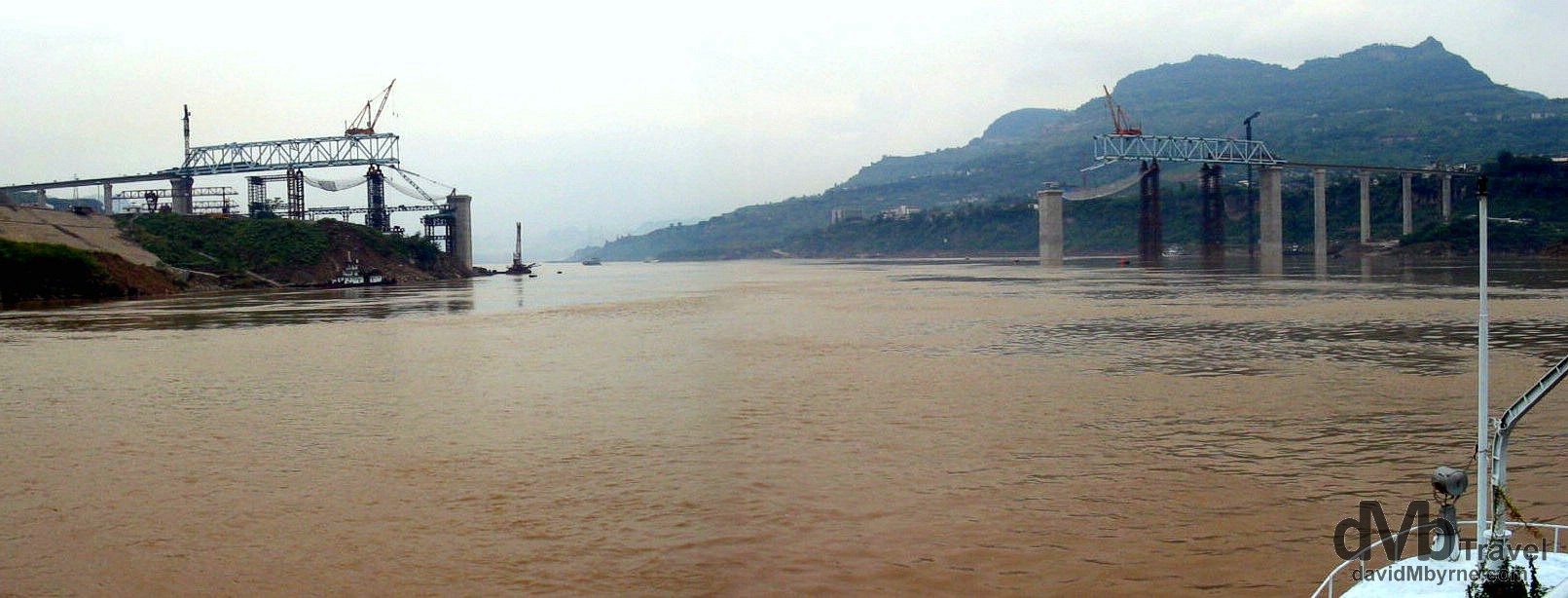
Day 1 || 14:50 || Yangtze River Bridge Construction || A panorama showing the construction of a bridge spanning the Yangtze. Although it appears to be well above the water level now (which it is), the rising water level will eventually bring the bridge closer to the water level, but (obviously) not close enough to hinder passing river traffic. On the Yangtze River near Wan Xian (![]() ), Chongqing, China. September 26, 2004
), Chongqing, China. September 26, 2004
Day 2 || Gorges, Large & Small, & a Bloody Big Dam
The ferry spent the bulk of night 1 docked at the ancient village of Baidicheng – boats on the Yangtze, whatever their size, seem, whenever possible, to only navigate the river during daylight hours. Immediately downstream of here is the entrance to the famous Yangtze River Three Gorges, the advertised highlight of any trip on the river. We had covered about two-thirds of the distance between Chongqing and Yichang in 1 day, meaning the rest of my time on the cruise was to be spent travelling through the Three Gorges, taking a side trip up the so-called Three Little Gorges & passing through The Three Gorges Dam, 200 kilometres downstream of Baidicheng, before docking in Yichang, my final destination 230 kilometres downstream of Baidicheng. So with quite a bit to look forward to on day 2 an early start was called for & at first light we started our journey through the Three Gorges.
Qutang, Wu & Xiling || The Three Gorges
The famed Three Gorges of the Yangtze River – Qutang, Wu & Xiling Gorges – span a 200 kilometre stretch of the river, although the gorges themselves occupy a stretch of only 120 kilometres. The gorges, classified as a AAAAA scenic areas (the highest level) by the China National Tourism Administration, are characterised by sharp bends constricted between towering limestone cliffs. Although primarily famous for its scenery, the Three Gorges region is also an historically and culturally important location in China, & just like other areas of the Yangtze many settlements and archaeological sites within the gorges are to be lost forever as a result of the rising water levels following the construction of The Three Gorges Dam.
Qutang Gorge
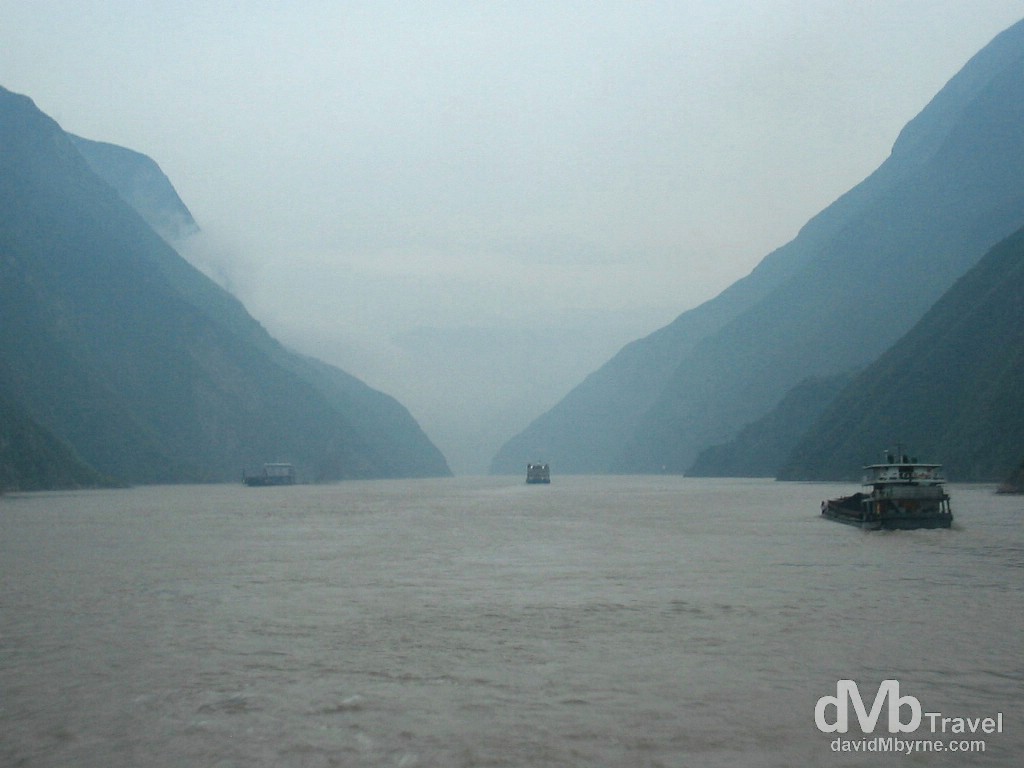
Day 2 || 06:34 || Entering Qutang Gorge (![]() ) as another day dawns on the Yangtze River. Qutang is, when travelling downstream, the first of the three Yangtze gorges. It’s only 8 kilometres (5.0 miles) long, making it by far the shortest of the three, & it’s also the narrowest – at its widest point it only measures 150 metres (500 ft) across. The mountains on either side reach as high as 1.2 kilometres (4,000 ft) and the combination of high peaks & narrow canyons means Qutang Gorge is regularly classed as the most beautiful of all the Three Gorges, something I would have to concur with. In fact, in comparison, Wu & Xiling Gorges didn’t feel like gorges at all. Entering Qutang Gorge of the Yangtze River, central China. September 27, 2004.
) as another day dawns on the Yangtze River. Qutang is, when travelling downstream, the first of the three Yangtze gorges. It’s only 8 kilometres (5.0 miles) long, making it by far the shortest of the three, & it’s also the narrowest – at its widest point it only measures 150 metres (500 ft) across. The mountains on either side reach as high as 1.2 kilometres (4,000 ft) and the combination of high peaks & narrow canyons means Qutang Gorge is regularly classed as the most beautiful of all the Three Gorges, something I would have to concur with. In fact, in comparison, Wu & Xiling Gorges didn’t feel like gorges at all. Entering Qutang Gorge of the Yangtze River, central China. September 27, 2004.
We exited Qutang Gorge and moored in Wushan later that morning, where we disembarked the ferry and boarded smaller, more navigable craft for a trip up the Daning River through the so-called Three Little Gorges.
The Three Little Gorges
The Three Little Gorges are a smaller version of the main Three Gorges, zigzagging for about 50 kilometres along the Daning River north of Wushan (![]() ). The lower reaches of the Daning River, the largest branch off of the Yangtze River, feature three (more) gorges, commonly known as The Three Little Gorges – Dragon Gate Gorge (Longmen Xia), Misty Gorge (Bawu Xia), and Emerald Gorge (Dicui Xia). Yes, three is certainly the magic number around here.
). The lower reaches of the Daning River, the largest branch off of the Yangtze River, feature three (more) gorges, commonly known as The Three Little Gorges – Dragon Gate Gorge (Longmen Xia), Misty Gorge (Bawu Xia), and Emerald Gorge (Dicui Xia). Yes, three is certainly the magic number around here.
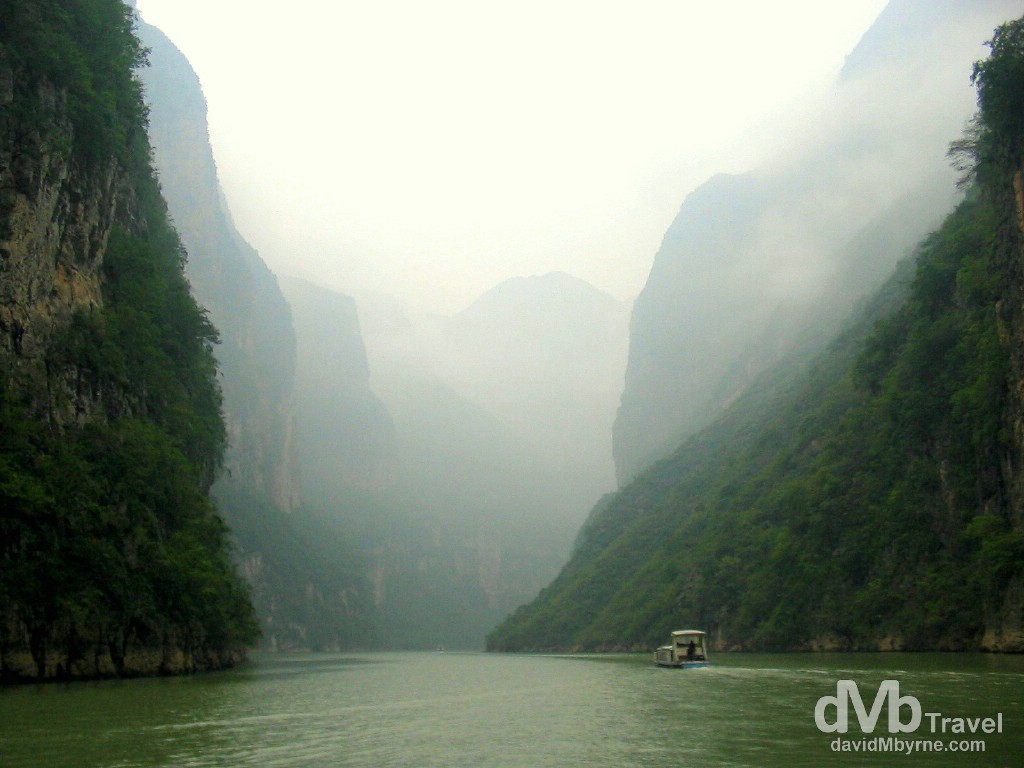
Day 2 || 09:41 || Entering the aptly named Misty Gorge. Also known as the Iron Coffin Gorge, Misty Gorge measures about 10 kilometres long. It is noted for a series of black coffins that hang suspended from the cliff above the gorge, the meaning of which I didn’t quite catch. The trip up the The Three Little Gorges were a more impressive, intimate & picturesque experience than the trip through the main Three Gorges of the Yangtze. The main reason for this was the the smaller craft used to navigate them. Misty Gorge of the Three Little Gorges, Daning River, Wushan, central, China. September 27, 2004
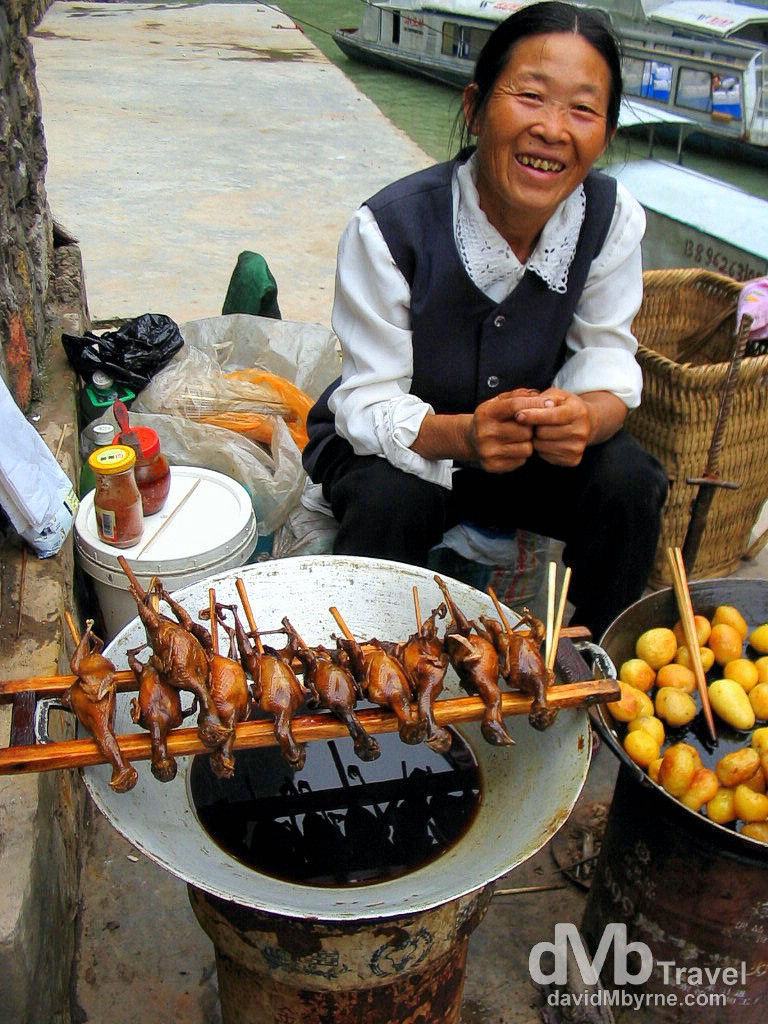
Day 2 || 10:37 || For sale in Misty Gorge. This was breakfast on day 2. Only the potatoes mind – I didn’t fancy the look of the sparrow on offer. In Misty Gorge of the Three Little Gorges, Daning River, Wushan, central China. September 27, 2004
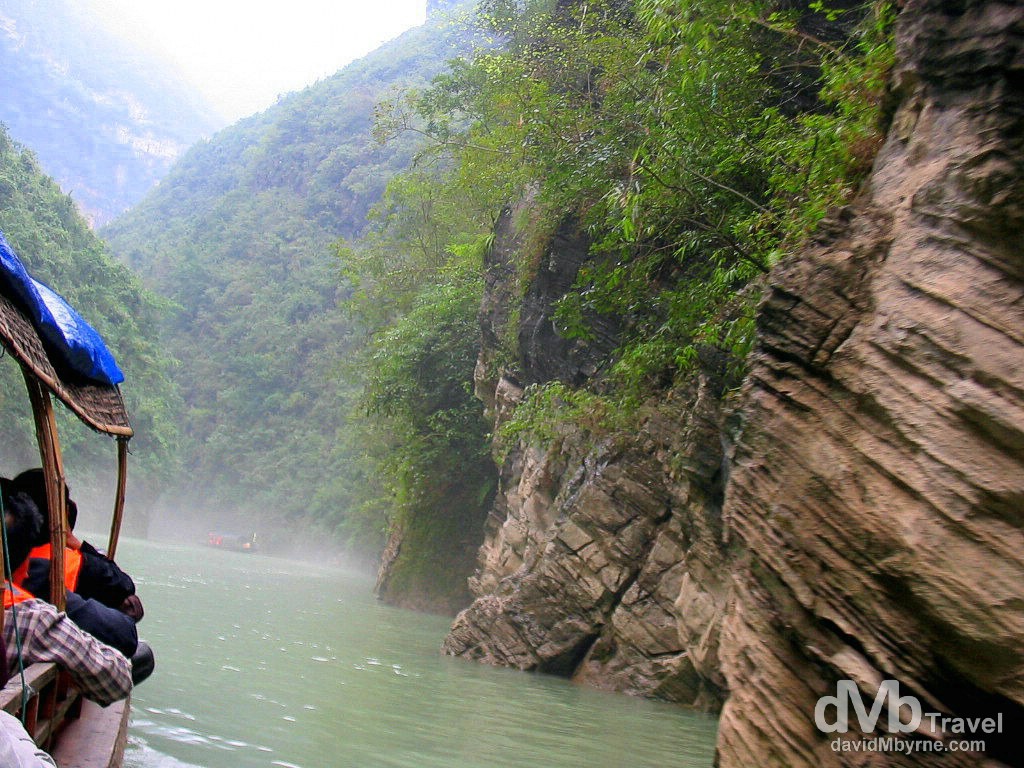
Day 2 || 11:30 || Boating on the Madu River of the Three Mini Gorges. As if the main Three Gorges & the Three Little Gorges weren’t enough, once we got to Misty Gorge of the Three Little Gorges we were once again transferred into another, even smaller boat this time for a trip up the even smaller and narrower Three Mini Gorges that feed off the Three Little Gorges. Confusing, eh? The boats were small, nimble craft that got very close to the gorge walls. On the Madu River of The Three Mini Gorges north of Wushan, central China. September 27th, 2004.
The Three Gorges Dam
Having returned to Wushan and re-boarded the ferry we resumed the trip down the Yangtze passing through the 45-kilometre long Wu Gorge before entering the final and longest of the Yangtze’s three gorges, the 66-kilometre long Xiling Gorge. Approximately half way through Xiling Gorge one’s progress is halted as spanning the middle of the gorge is none other than the biggest and most ambitious construction project on the planet – The Three Gorges Dam. And getting through it takes time. A lot of time.
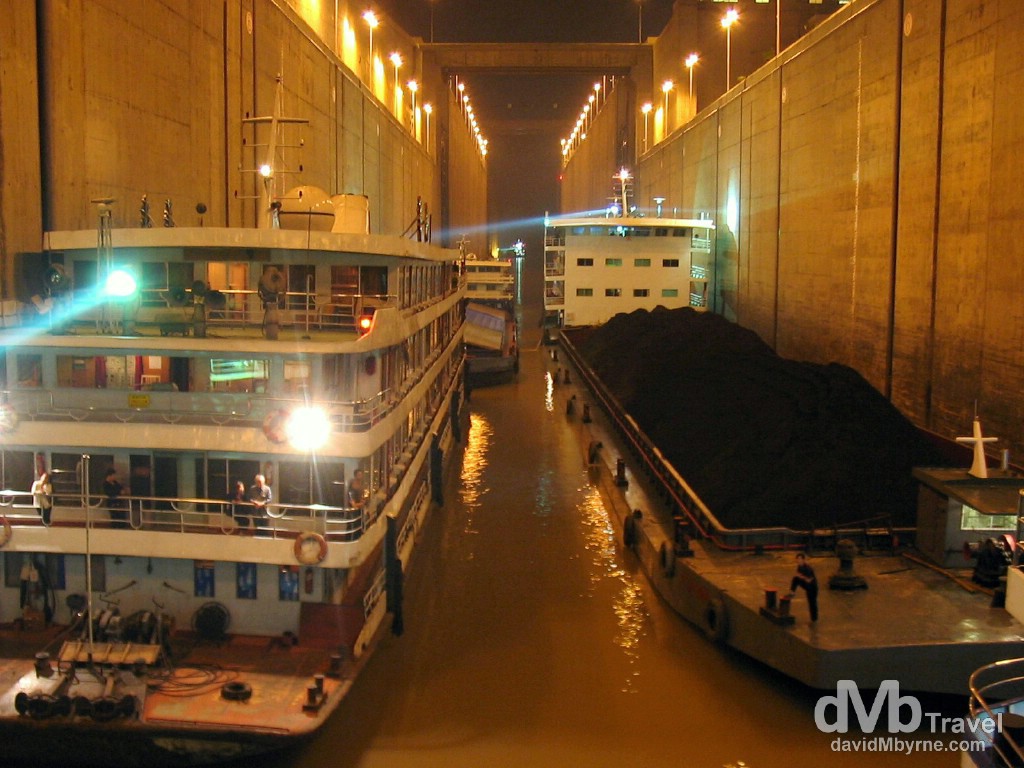
Day 2 || 21:41 || Boats entering one of the gargantuan bays of a lock of The Three Gorges Dam. Standing on the deck of the ferry witnessing the jostling of these huge boats and seeing the lock bay doors opening and closing made me feel very small. Very small indeed. It took forever to get all the boats into position, close the rear bay doors, lower the water level and open the front bay doors. And when all this was done we’d move forward into another lock bay only to repeat the process all over again. And again. And again. I stood out on the deck for over 5 hours waiting for the ferry to finally clear the lock so I could get a view of the dam wall as we moved away from it. But every time the door to exit a lock bay opened, we would enter another bay. We reached the dam at approximately 21:00. I was already tired (it had been a long day). I held out until approximately 02:00, by which time we were still in a seemingly endless loop of exiting one lock bay only to enter another. The Three Gorges Dam (![]() ) near Yichang, Hubei Province, central China. September 27, 2004
) near Yichang, Hubei Province, central China. September 27, 2004
The Dam Yangtze || The Three Gorges Dam
The Yangtze River is an important transport and shipping corridor, & has been for centuries. But today it is also a scene of controversy. Throughout history flooding along the river valley has caused great destruction of life and property. In November 1997 Chinese engineers, in a bid to control the flooding, diverted the main channel of the river, clearing the way for construction of the massive Three Gorges Dam, the world’s largest hydroelectric project.
Construction proper began in 2002 and is scheduled for completion in 2009. It is the biggest and most ambitious construction project on the planet; the dam will measure 186 metres high, 2 kilometres wide, & will measure 115–40 metres deep from bottom to top. All told it will cost in the region of RMB180 billion (€17 billion, USD$22.5 billion). It will create a reservoir stretching back from the dam measuring about 650 kilometres (400 miles) in length, permanently flooding many existing towns (including numerous ancient cultural relics), causing large-scale changes in the local ecology and forcing the relocation of an estimated 1.2 million people. Opponents of the dam point out that there are three different kinds of floods on the Yangtze River: floods which originate in the upper reaches, floods which originate in the lower reaches, and floods along the entire length of the river. They argue that the Three Gorges Dam will actually make flooding in the upper reaches worse and have little or no impact on floods which originate in the lower reaches.
Day 3 || Attempting To View The Three Gorges Dam
Having docked in Yichang during the early hours of day 3, I was allowed to stay on board, & thus in bed, before having to disembark the ferry at the more reasonable hour of 6 a.m., bringing an end to my Yangtze River cruise adventure. However, I felt I had unfinished business with the Three Gorges Dam, so having quickly secured onward train tickets for the overnight train that evening north to Xi’an in Shaanix province, I found myself en route to the dam site, about a 30 minute local minibus ride from Yichang. I had spent about 5 hours on the forward deck of the ferry last night watching as we passed through an endless expanse of hydraulic locks, one after another, after another, but needless to say I failed to get a good look at the dam itself. And unfortunately having made the effort to view it from the banks of the Yangtze River itself I still didn’t get a satisfactory view.
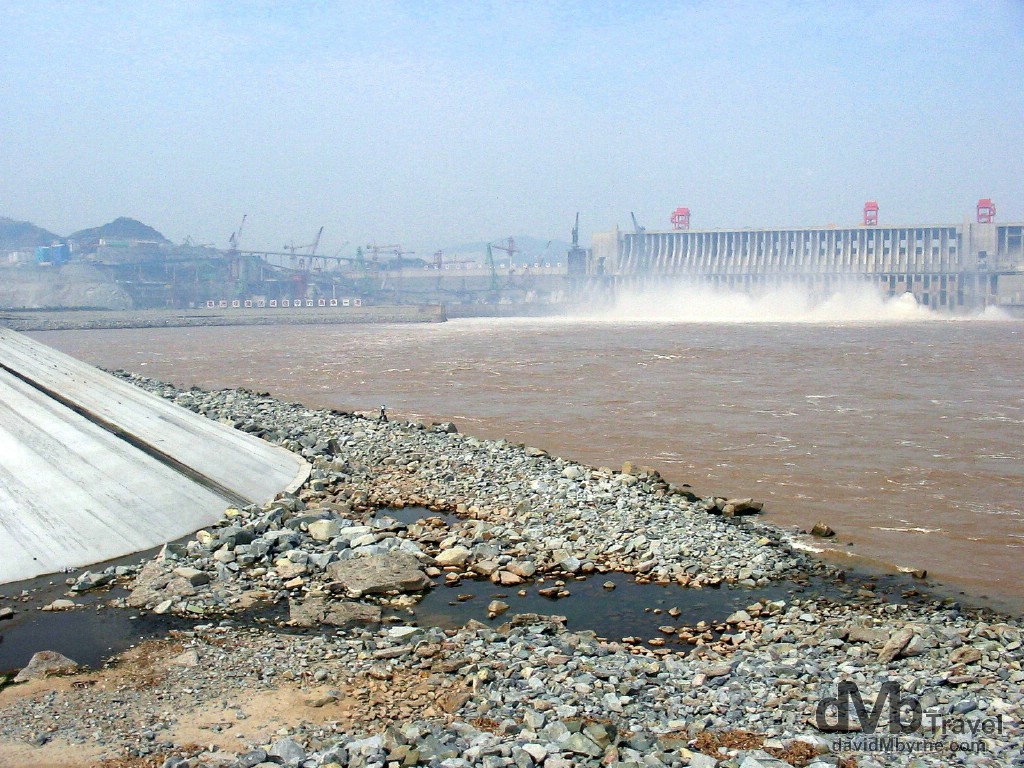
Day 3 || 11:28 || It’s difficult to get near the dam without joining a ludicrously expensive tour of the construction site itself so the nearest I could get to the actually 186 metre-high dam wall was a vantage point some, I’d estimate, 2 kilometres away. But even from that distance the size of the dam and the scale of the construction project were astounding. Unfortunately it’s the best image I have of the dam (camera issues). Even from this distance it just looks like a wall, albeit a very big, incomplete, 2 kilometre-wide, 186 metre-high, leaking (in a controlled manner of course) wall of Chinese concrete. At this stage about two-thirds of the dam is complete with the remaining third under construction out of frame. The dam is supposed to stop flooding upstream and create a valuable source of income for the area via electricity generation but, & after spending the previous 2 days sailing down the Yangtze River and seeing firsthand the affect that damming the river will have on the landscape and the millions of people who will be displaced by its construction, one has to wonder if it’s all worth it. I guess only time will tell. Near The Three Gorges Dam outside Yichang in Hubei Province, central China. September 27th, 2004.
Yangtze River Cruise Interactive Highlights Map
Moving On
From Yichang it was north to Xian, home to the famed Terracotta Army, one of China’s premier attractions.
